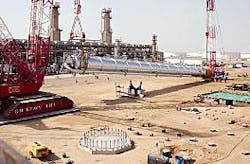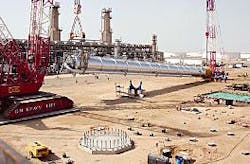Saudi Aramco has completed a project to recover iso-pentane at its Yanbu’ gas terminal for use in gasoline blending, a project designed to help meet the kingdom’s increasing demand for gasoline, according to Ahmad A. Dialdin, writing last month in Saudi Aramco Week.
Blending
The new facility is designed to process about 15,000 b/d of mixed pentane to produce 5,500 b/d of iso-pentane. Once extracted, the iso-pentane is pumped through an 8-mile pipeline to the Yanbu’ refinery for gasoline blending.
Adding 5,500 b/d of iso-pentane to the gasoline pool at Yanbu’ refinery, said Dialdin, goes a long way toward optimizing the use of oil and gas and increasing the company’s revenues by about $8.1 million/year.
Currently, NGLs are piped from Shedgum and ‘Uthmaniyah through the East-West Pipeline to the NGL plant in Yanbu’. The NGL feedstock goes through several rounds of fractionation into ethane, propane, butane, and natural gasoline, most of which are used locally with the rest being exported. The gasoline is fractionated in the Reid vapor pressure (RVP) column to extract mixed pentane and to meet a grade specification.
Before completion of the iso-pentane recovery project, said Dialdin, this rich pentane stream from the RVP column had little value other than to be mixed into the crude oil. The just-completed project allows processing into an excellent gasoline ingredient known as iso-pentane.
Dialdin said the gasoline currently used in Saudi Arabia contains light straight-run naphtha and butane, among other ingredients. As an additive, the iso-pentane will improve fuel efficiency and performance and reduce emissions.
DIP column
All the major vessels, such as the reboilers, drums, and the 73.5-m de-iso-pentanizer (DIP) distillation column were manufactured in the kingdom, he said.
In March of this year, the new, 375-ton DIP column was lifted with 1,250-ton and 500-ton cranes in tandem. The 73 m, 5.8-m diameter column was fabricated by a Saudi manufacturer in Jubail, then transferred in four large pieces to Yanbu’, where the assembly was completed and final testing took place. ✦

